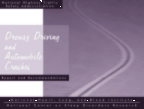|
skip
nav




|
What is
the Mission of Drowsy Driving Program?
Every year, falling asleep
while driving is responsible for at least 100,000 automobile crashes,
40,000 injuries, and 1550 fatalities. These crashes happen between the
hours of midnight and 6am, involve a single vehicle and a sober driver
traveling alone, with the car leaving the roadway without any attempt
to avoid the crash. These figures underestimate the true level of involvement
of drowsiness because they do not include crashes involving daytime hours,
multiple vehicles, alcohol, passengers, or evasive maneuvers.
NHTSA's programs to combat
drowsy driving employs both educational and technological solutions.
Education programs are directed toward specific subpopulations as well
as the general driving public. Current educational efforts to combat
drowsy driving are directed at shift workers and college students,
using social marketing approaches to determine appropriate messages
and delivery mechanisms. Programs increase awareness of the need for
sleep and provide information on how to get better quality sleep, how
to recognize when a driver is fighting sleep, and what to do when the
driver is too sleepy to drive.
"Volume I: Findings--National
Survey of Distracted and Drowsy Driving Attitudes and Behavior --
2002".
Also available in .pdf
(Cover)
This report presents the findings from a national survey conducted by
the Gallup Organization for NHTSA during February through April of 2002.
Topics covered in this report include general driving characteristics
and road use, distracted driving behaviors including wireless phone use,
and characteristics of drowsy driving behavior.
“Volume II: Findings— (Cover)
National Survey
of Speeding and Unsafe Driving Attitudes and Behavior: 2002”.
available in pdf. (posted 11-18-03)
This
report presents findings from a national survey conducted by the Gallup
Organization for NHTSA during February through April of 2002 on American
drivers' reported behaviors and attitudes surrounding speeding, and aggressive
driving and and other unsafe driving behaviors.
Preventing
Drowsy Driving Among Shift Workers Program (posted 11-00)
In collaboration
with the National Center on Sleep Disorders Research (NCSDR), NHTSA has
developed this program to increase shift workers' awareness of the dangers
of drowsy driving, help them to improve the quality of their sleep and
reduce sleepiness, and - ultimately - reduce the incidence of drowsy driving.
- The
NHTSA & NCSDR Program to Combat Drowsy Driving
In 1996,
NHTSA & NCSDR embarked on a congressionally mandated effort to develop
educational countermeasures to the effects of fatigue, sleep disorders,
and inattention on highway safety. This publication is their report
to Congress.
Drowsy
driving and Automobile Crashes
Drowsy driving is a serious problem that leads to thousands of automobile
crashes each year. This report, sponsored by the National Center on Sleep
Disorders Research (NCSDR) of the National Heart, Lung, and Blood Institute
of the National Institutes of Health, and the National Highway Traffic
Safety Administration (NHTSA), is designed to provide direction to an
NCSDR/NHTSA educational campaign to combat drowsy driving. The report
presents the results of a literature review and opinions of the Expert
Panel on Driver Fatigue and Sleepiness regarding key issues involved in
the problem.
|

